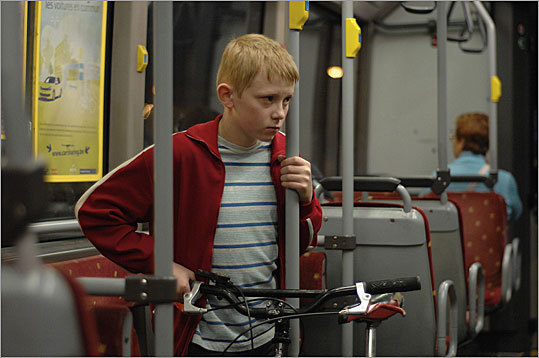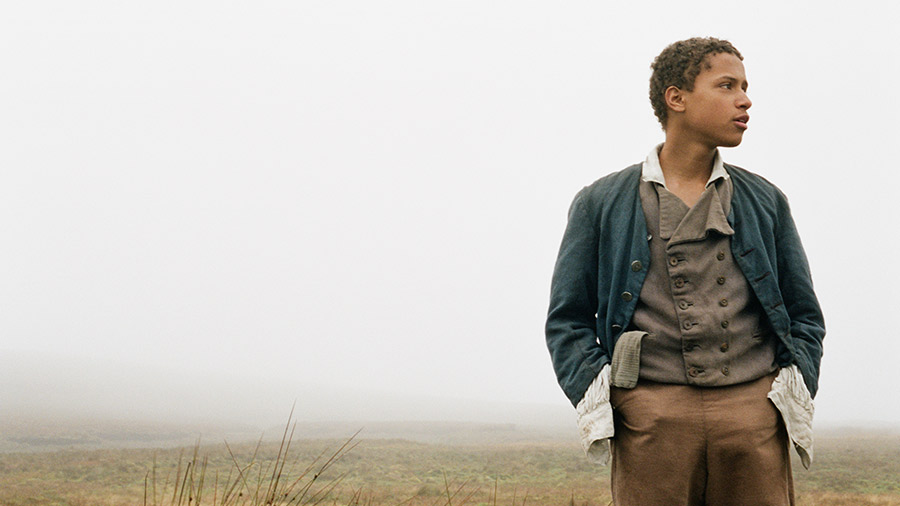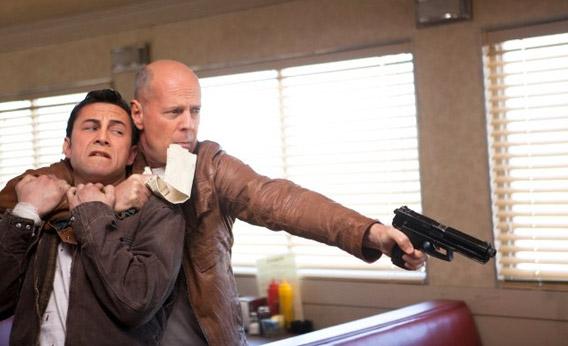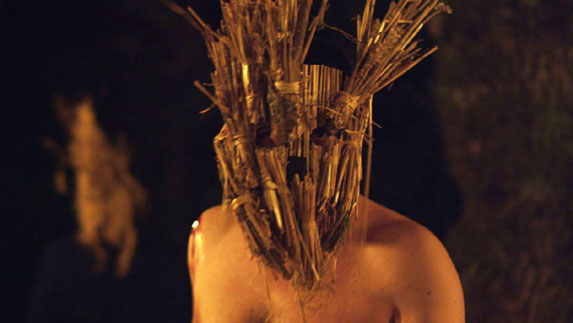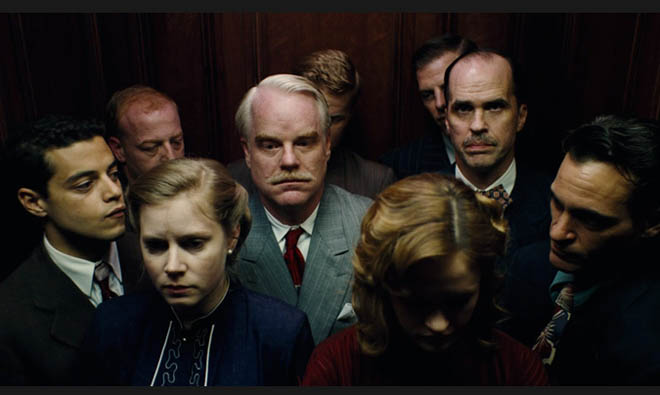
25: The Dark Knight Rises
Directed by Christopher Nolan
Screenplay by Jonathan Nolan and Christopher Nolan
2012, USA
The Dark Knight Rises feels as if it was made up of two equal halves, with the most critical moment of the film breaking the movie in half, almost literally. While the second half may have been a let down, the first half is incredibly ambitious to say the least. The opening sequence, a gravity-defying skyjacking, is a tour de force – wildly choreographed, vivid, visceral, and chock full of suspense. That aerial extraction alone is worth the price of admission. Production-wise, effects-wise, Nolan’s movie (with sequences shot with Imax cameras) is staggering. There was an opportunity here for Nolan to stretch the boundaries of what is possible in the genre, alas, the final act becomes a little too conventional – complete with a doomsday device and a ticking-clock countdown. But for every quibble, The Dark Knight Rises remains an excellent summer blockbuster, but just not the best film of the year.
24: Cabin In The Woods
Directed by Drew Goddard
Screenplay by Joss Whedon and Drew Goddard
The clever, high-concept Cabin In The Woods is without a doubt the best and most inventive cabin-in-the-woods picture since Sam Raimi’s Evil Dead 2. It is also the most clever genre deconstruction since Wes Craven’s Scream. Screenwriters Drew Goddard and Joss Whedon tease us with a simple set-up, only to turn the joke upside down and on its head. Crammed with small unanticipated and unexpected incidents and comical twists, director Drew Goddard defies conventions while demonstrating a strong understanding of modern horror. This over the top blend of Scream and The Adjustment Bureau puts a clever spin on Whedon’s longstanding obsession with violence and voyeurism. With two interwoven narratives taking place at once, Goddard’s multi-layered approach is ambitious – digging deeper than a self-reflexive game of name-checking. A horror film embedded in a conspiracy flick embedded within another horror movie, Cabin is a must see, if only for the final 20 minutes, in which all Hell breaks loose.
23: The Raid: Redemption
Directed by Gareth Evans
Screenplay by Gareth Evans
Much like Die Hard, The Raid is built on a simple premise: a group of police officers in Jakarta infiltrate an apartment complex which houses a dangerous gangster and his dozens of thugs, who control the majority of the drug trafficking within the city. You can’t get a more straightforward story than what you have here. This is a movie that doesn’t want too spend much time getting bogged down with deep character development or exposition; the dialogue is limited that subtitles are rarely needed. There are good guys and bad guys and a shitload of high testosterone and adrenaline.
Winner of the Midnight Madness People’s Choice Award at last year’s Toronto International Film Festival, The Raid is brutal, bloody and violent. In fact, the fight scenes comprise about 75% of the running time. Some are long, others brief, but they’re always varied. Welsh-born director Gareth Evans, working on his third feature (the second of this kind) has an especially good understanding of how to choreograph and stage the fight scenes without the need of excessive shaky cam or flash cutting (note that Evans also takes on editing duties). Unlike many American Hollywood filmmakers, Evans gives us a clear view of every punch, kick, and gunshot.
Although there is some gunplay, the majority of the high-octane confrontations are hand-to-hand; the particular martial art on display here is the Indonesian art-form known as pencak silat. Characters shoot, stab, punch, and kick their way thought the apartment complex, through corridors, through ceilings, up and down stairs and even busting through the floorboards. Body parts twist, snap and break into peculiar positions; heads are smashed into walls, men are slammed against the ground, and one man is even used as a human shield while diving out of the 15ht floor window. Let us not forget the jagged segment of a broken fluorescent tube that practically decapitates a man. The Raid: Redemption is not a particularly edgy or daring film, but action aficionados will not be disappointed with its unapologetic balls-to-the-wall fight sequences.

22: Deep Blue Sea
Directed by Terrence Davies
Written by Terrence Davies
Featuring an outstanding performance by Rachel Weisz, The Deep Blue Sea is perhaps the best film from acclaimed director Terence Davies. This is a beautifully photographed film which starts with an outstanding long crane shot and later gives us one of the best extended takes in any film released this year. Recommended for anyone looking for superb acting and lush cinematography.
21: Kid With A Bike
Directed by Jean-Pierre and Luc Dardenne
Screenplay by Jean-Pierre and Luc Dardenne
Winner of the Grand Jury Prize at last year’s Cannes Film Festival and a Golden Globe nominee for Best Foreign Language Film, The Kid With a Bike is essentially a movie about the consequences of parental abandonment, and how those consequences play out for the child involved. The boy in question, 11-year-old Cyril, is relentlessly on the move – it’s a bumpy ride it is impossible to guess exactly where things are headed next. For Cyril, recovering his missing bike brings him one step closer to reuniting with his dad; its an obsession so clearly doomed and an obsession guided by denial. Only when Cyril stops moving do possibilities for a future present themselves, although sometimes those moments can lead him in the wrong direction.
20: Killer Joe
Directed by William Friedkin
Screenplay by Tracy Letts
2011, USA
Killer Joe marks an unshakeable return for William Friedkin, the legendary director of The French Connection, To Live And Die In L.A. and The Exorcist. Joe is a frenzy of overblown characters, sights and sounds structured around a cartoonish vision of southwestern tackiness and dark humorous explorations of family values. At age 76, William Friedkin hasn’t lost a single step, and offers the ballsiest ending of any film I’ve seen all year, not to mention a nightmarish vision of Colonel Sanders’s sexual fantasies.
19: Wuthering Heights
Directed by Andrea Arnold
Screenplay by Olivia Hetreed
2011, UK
Based on Emily Brontë’s gothic novel from over 160 years ago, Wuthering Heights is a surprising choice for Andrea Arnold’s third feature. Fans of previous film adaptations are most likely to be disappointed in the new big screen version as this radical new take is refreshingly different. Wuthering Heights has been adapted numerous times, with both Luis Buñuel and Jacques Rivette filtering the story through their own individual personalities and surroundings. Arnold’s work can be placed alongside those great adaptations. Credit Arnold for adapting the original source material to her very own distinct, dark and twisted vision. This is a visual poem that almost doesn’t feel like a period film at all.
18: Looper
Directed by Rian Johnson
Written by Rian Johnson
2012, USA
With his third film, director Rian johnson (Brick, Brother’s Bloom) has expanded his scope as a filmmaker. Looper is a unique, smart, original futuristic sci-fi/fantasy with a dose of hard-hitting drama and crafted with great loving care and attention to detail. Looper has well-developed characters, plenty of action, a ton of suspense and the most creative torture scene you’ll ever see. Think The Terminator with a twist and mixed with a variety of genres and influences including, film noir, dark comedy, romance and even westerns. If you are a fan of time-travel movies, you’ll love it.

17: Damsels In Distress
Directed by Whit Stillman
If only more rom-coms were as good as the films of director Whit Stillman. Damsels In Distress brims with dry wit and whimsy observations and excels due to the perfectly contained performance by Greta Gerwig as Violet. Set on the campus of a fictional East Coast college, Damsels revolves around a set of trio of beautiful college girls as they set out to revolutionize life at a an American university by helping severely depressed students with a program of good hygiene and musical dance numbers. Damsels is pure entertainment and holds up with repeated viewings. I’ve watched it three times already.

16: Miss Bala
Directed by Gerardo Naranjo
Screenplay by Gerardo Naranjo and Mauricio Katz
Loosely based on a true story, Miss Bala (Mexico’s 2012 submission for Best Foreign Language Film) tells the story of Laura, a young woman who, after signing up for the local beauty pageant, finds herself the accidental pawn of a drug cartel. The entire film unfolds from the perspective of a naive Tijuana teenager, shot mostly with sharp extended tracking shots, widescreen compositions and over-the-shoulder perspectives that help convey the widespread corruption and menace surrounding the young girl. This first-rate art-house thriller has been criticized as more of a collection of standout scenes than a fully realized story, but perhaps the audience is meant to feel just as confused and disoriented as the protagonist. If you are looking for something refreshingly different, than look no further; Bala will have you scratching your head trying to make sense of all the chaos which unfolds.

15: Sightseers
Directed by Ben Wheatley
Written by Steve Oram and Alice Lowe
It’s no big secret I’m a huge fan of director Ben Wheatley, so there shouldn’t be any surprise that two of his films crack my top 20. Sightseers, a bloody, satirical road trip comedy is by no means as great as Mallick’s Badlands, but it is truly unique, strange, disquieting, and uncomfortably funny. Working for the first time from someone else’s script – Sightseers was written by TV acting and writing duo Alice Lowe and Steve Oram, with input from Wheatley’s longtime collaborator Amy Jump. The pair first devised the characters for an unsold TV pilot which was rejected by every UK broadcaster for being too dark. Wheatley is one of the most exciting genre filmmakers working in the industry today and has a talent for coaxing naturalistic, improvisational performances from his actors. In Sightseers he achieves the relatively rare feat of striking the right balance between sharply observed characterization and jet black humour.
14: Kill List
Directed by Ben Wheatley
Screenplay by Ben Wheatley and Amy Jump
Kill List is presented in three distinct but smartly connected tissues: Ben Wheatley and his wife and scriptwriting partner, Amy Jump, have created somewhat of a kitchen-sink gothic horror film that blends black comedy, domestic drama and the whole buddy hit-man movie element into a seamless whole. Utterly gripping, deeply unsettling and genuinely terrifying, Kill List is remarkably clever and resourceful filmmaking. This is a brilliantly directed, superbly written British horror film with terrific performances from its skillful cast of actors that will be dissected and argued long after the credits role.
13: Rebelle (War Witch)
Directed by Kim Nguyen
Screenplay by Kim Nguyen
Somewhere in Sub-Saharan Africa, Komona, a 14-year-old girl, tells her unborn child growing inside her the story of her life since she has been at war. That basically sums up Kim Nguyen’s Rebelle, one of the frontrunners for this year’s coveted Berlinale Golden Bear award and winner of the jury prize for best narrative feature at Tribeca. This harrowing film excels with disciplined direction, lively music, striking imagery, moments of levity and powerful performances by a predominately young, semi-professional cast – all of whom completely encase their characters by adding a much-needed dose of humanity. Rebelle continues the ongoing tradition of groundbreaking Quebecois cinema – specifically here in my hometown, Montreal.
12: Beasts of the Southern Wild
Directed by Benh Zeitlin
Screenplay by Lucy Alibar, Benh Zeitlin
2012, USA
Anchored by one of the year’s best scores, Beasts of the Southern Wild is an emotionally powerful journey led by a powerhouse performance from newbie Quvenzhané Wallis. Beasts also marks one of the most promising American directorial debuts in recent times. Benh Zeitlin’s imagination is almost as pure as the ignorance from the perspective of the film’s central character. This strange tone poem about childhood and innocence seen through the eyes of six-year old Hushpuppy, oozes with energy, boldness and sincere passion. In short, Beasts conveys everything we love about movies, by successfully engulfing us into a world we ourselves could never dream.

11: Lincoln
Directed by Steven Spielberg
Written by Tony Kushner
It is remarkable how Steven Spielberg, after all these years can still direct with such precision, passion and skill. But Lincoln is unlike any Spielberg film – it is a complete character study. And while the film’s themes are powerful, Lincoln stands tall because of Daniel Day-Lewis, whose performance towers over any other actor this year. Day-Lewis doesn’t just play Lincoln; he inhabits him. Spielberg, Day-Lewis, cinematographer Janusz Kaminski and screenwriter Tony Kushner deliver a great American movie about a great American President. Come Oscar time, I’m placing all my bets on these four men.
10: Moonrise Kingdom
Directed by Wes Anderson
Screenplay by Wes Anderson and Roman Coppola
2012, USA
Moonrise Kingdom is best described as an offbeat underage love story that resembles a fractured fairy tale. Kingdom is lovingly crafted with an attention to detail that is breathtaking. Cinematographer Robert Yeoman, Anderson’s usual collaborator shoots on 16-millimetre stock that gives the images a warm nostalgic feel and the soundtrack/score is not only incredible – but one of the greatest ever assembled for the big screen. Anderson may be a little too calculated and a little too clinical in his direction, but he still gift wraps this package with some wonderful scenes: Without a doubt the goofy dance sequence which leads to an uncomfortable first kiss is by far the highlight. The leads Jared Gilman and Kara Hayward are excellent given it is their first major film role, exhibiting none of the stiltedness and uncertainty that you would expect from amateur actors. Moonrise Kingdom is tender, sweet, awkward, smart, low-key and gets better with every added watch.

9: Berberian Sound Studio
Directed by Peter Strickland
Written by Peter Strickland
UK, 2012
Berberian Sound Studio reminds us of the power of sound over the visual image, and can surely join the ranks of Francis Ford Coppola’s The Conversation and Brian DePalma’s Blow Out as an absorbing appreciation of sound design. But both thematically and visually, Berberian is more of a descendant of the school of David Lynch and Roman Polanski. As things get increasingly, insanely bizarre, a pervasive mood of exploitation and corruption seeps through every frame. Although shot on a limited budget, the detail in this film is exquisite. Cinematographer Nic Knowland’s dreamlike imagery is mesmerizing and the Goblin-esque music from Broadcast is terrifying.

8: Skyfall
Directed by Sam Mendes
Written by John Logan, Robert Wade and Neal Purvis
Skyfall, the 23rd film in the Bond cannon, seems a necessary step in the right direction for the long running franchise. Skyfall is stand alone entertainment for those not familiar with the history of the super-spy while still offering fanboys nods to the classics. Sam Mendes proves he can direct action while raising the emotional stakes to a new level. His staging of Skyfall’s action sequences are expertly done – the confrontation between Bond and bad guy Patrice with the electrified backdrop of Shanghai’s skyline in the background is simply a thing of beauty – As is the well-constructed sequence involving a car chase, a shootout, a motorcycle chase across the rooftops of Istanbul and a duel on top of a moving train. No other team has since matched the talents gathered from the Sean Connery era – until now. Academy Award winners Sam Mendes, cinematographer Roger Deakins, production designer Dennis Gassner and actor Javier Bardem collectively pull their talents to create the best, if not second best Bond outing yet.

7: This Is Not A Film
Directed by Mojtaba Mirtahmasb and Jafar Panahi
Written by Jafar Panahi
What is it about Iranian cinema? Do these dudes make bad movies? This heartbreaking documentary of filmmaker Jafar Panahi under house arrest in Tehran, and prohibited from making movies is simply brilliant. Shot partially on an iPhone, the film depicts the day-to-day life of the acclaimed filmmaker responsible for such gems as Offside and The Circle. Panahi creates a very personal film that reveals much about himself while discussing his plight with Mirtahmasb and reflecting on the art of filmmaking. We are also introduced to his pet iguana, Igi. But seriously, this is arguably the best Iranian film since Abbas Kiarostami’s Close-Up. Watch it.
6: The Turin Horse
Directed by Bela Tarr and Ágnes Hranitzky
Written by László Krasznahorkai and Bela Tarr
Bela Tarr is known as the Hungarian master of minimalist cinema and one of the greatest moviemakers of all time. At age 56, he sadly announced his retirement and The Turin Horse to be his final film. What better way to retire than with a starkly beautiful and exceedingly demanding meditation on the human condition. Here Tarr co-directs with his wife, Ágnes Hranitzky, and shares writing credit with novelist László Krasznahorkai, with whom he adapted one of his classic works, 1994’s Sátántangó, among others. The Turin Horse is a dubious story of Nietzsche, when in 1889, he saw a man abusing his horse and decided to intervene. Warning: The Turin Horse will bore 99% of audiences – but lovers of vivid atmospheric films will find themselves mesmerized. This is essential viewing for the braver, more discerning/patient filmgoer; a remarkable expressive black-and-white film with a haunting score, brilliant sound design, Tarr’s trademark long takes and the longest-most beautiful establishing shot you’ll ever see.
5: Once Upon A Time In Anatolia
Directed by Nuri Bilge Ceylan
Screenplay by Nuri Bilge Ceylan and Ebru Ceylan
Nuri Bilge Ceylan is one of the most interesting directors working on the international scene, and Once Upon A Time In Anatolia might just be his best movie to date. This being his sixth feature, it won the Grand Prize at Cannes last year and as since received critical acclaim around the world.
In this metaphysical quasi-police procedural, a group of men (including a police commissioner, a prosecutor, a doctor and a murder suspect) drive out in the middle of the night through the Anatolian countryside, in search of a corpse. The mystery isn’t who the killer is but instead where the body was buried since the suspect, who claims he was drunk, can’t remember where he left his victim. The drama unfolds mostly offscreen but Anatolia is overflowing with deception, betrayal and violence from the start. Nothing is what it seems; when the body is found, the real questions begin to creep up.
Anatolia is a non traditional, unique and refreshing crime investigation, that is at times darkly funny, subtle and always gorgeous to look at. Cinematographer, Gohkan Tiryaki brilliantly uses light as a storytelling tool. The bare facts of the case emerge from the shadows, and the essential mystery deepens into the long night. The performances are as impeccable as the look; Anatolia is a crime story with emotionally layered characters and the acting here is superb, but it’s Ceylan’s mastery of composition and pacing (made with such confidence) that ranks Anatolia as one of the best films in recent memory. A must see!
4: The Master
Directed by Paul Thomas Anderson
Written by Paul Thomas Anderson
2012, USA
Much like Paul Thomas Anderson’s previous movie There Will Be Blood, The Master is a portrait of megalomaniac. It is about character interaction, not character development – a study of two souls searching for answers and for belonging. It is also one of the most technically impressive films of the year and one that satisfies on many levels. This is the work of a true artist and quite possibly the best American filmmaker working today. The Master is smart, incredibly well acted, exquisitely shot and assembled with meticulous artistry. While it might be the least accessible film from the director’s cannon, it is nevertheless a film that demands to be seen by any true hardcore cinephile.

3: Holy Motors
Directed by Leos Carax
Written by Leos Carax
Holy Motors is a carefully structured work of art; reflective, palpable, playful, absurd, precise and entirely engrossing. Motors is a prime reminder or why cinema is so treasured and celebrated. In this film, as in life, nothing is explained and things just get stranger by the minute. Motors is Carax’s love letter to cinema; here he summons everything from the earliest observational use of the camera, to the more advanced aspects of the digital age and every adventure Oscar embarks in could be regarded as representing a cinematic genre: Drama, comedy, tragedy, mystery, thriller, erotica and even a musical. Sometimes Oscar’s roles are clearly bizarre, other times they have a touching, naturalistic quality.
2: Tabu
Directed by Miguel Gomes
Written by Miguel Gomes
Portugal, 2012
With his third feature, Portuguese critic-turned-auteur Miguel Gomes has proven himself to be a director in complete control of his craft. Tabu is a film of artistic cool – breaking classic genre conventions in the most crafty and affectionate way by consistently subverting the narrative in a beautiful dreamlike style. Gomez has directed a film that channels the look and feel of classic Hollywood, and one that will transport you back to the golden age of cinema. Tabu is a universal tale about love, passion, friendship and betrayal – an exquisitely-cut gem and a rarity for our time. Recommended for patient moviegoers and those looking for something fresh.

1: How to Survive a Plague
Directed by David France
How to Survive a Plague is a compelling look at LGBT protesters during the AIDS crisis in the 80′s and 90′s. The story follows two coalitions, ACT UP and TAG (Treatment Action Group), whose activism and research turned AIDS from a death sentence into a liveable condition. Plague isn’t about the history of the disease, instead about the history of a movement. Despite having no scientific training, these self-made activists provided a template of how grassroots activism can temper societal and governmental prejudice. In challenging the pharmaceutical industry, these men and women helped discover promising new drugs, while fighting to move them from experimental trials and directly to patients in record time. First time filmmaker David France transports viewers right in the moment of the height of the crisis by using everything in his reach: interviews, broadcasts, news reports, home videos and more. When it’s over, this documentary lingers as a testament of extraordinary determination and the will to survive. How To Survive A Plague is impressionistic in its scope, extremely moving, astonishing, important and downright inspiring. No other film in 2012 left me with tears flooding down my cheeks.
– Ricky D
[button align=”right” color=”red” caption=”PART ONE / PREVIOUS” link=”http://www.popoptiq.com/ricky-ds-50-favourite-films-of-2012-part-one/”]




